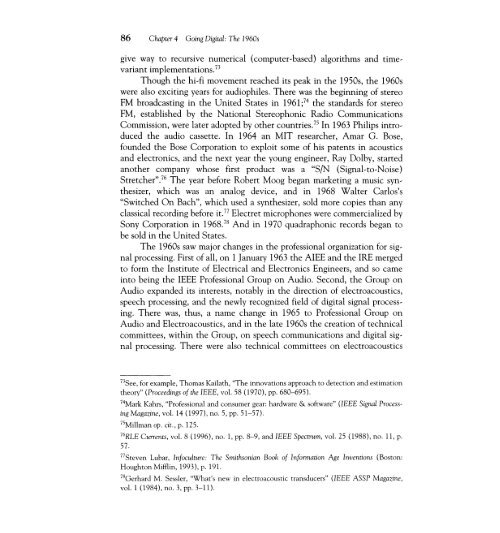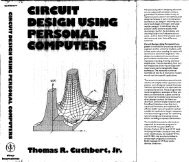Going Digital: The 1960s - IEEE Global History Network
Going Digital: The 1960s - IEEE Global History Network
Going Digital: The 1960s - IEEE Global History Network
You also want an ePaper? Increase the reach of your titles
YUMPU automatically turns print PDFs into web optimized ePapers that Google loves.
86 Chapter 4 <strong>Going</strong> <strong>Digital</strong>: <strong>The</strong> <strong>1960s</strong><br />
give way to recursive numerical (computer..based) algorithms and time..<br />
variant implementations.73<br />
Though the hi..fi movement reached its peak in the 1950s, the <strong>1960s</strong><br />
were also exciting years for audiophiles. <strong>The</strong>re was the beginning of stereo<br />
FM broadcasting in the United States in 1961;74 the standards for stereo<br />
FM, established by the National Stereophonic Radio Communications<br />
Commission, were later adopted by other countries. 75 In 1963 Philips intro..<br />
duced the audio cassette. In 1964 an MIT researcher, Amar G. Bose,<br />
founded the Bose Corporation to exploit some of his patents in acoustics<br />
and electronics, and the next year the young engineer, Ray Dolby, started<br />
another company whose first product was a "SIN (Signal..to..Noise)<br />
Stretcher".76 <strong>The</strong> year before Robert Moog began marketing a music syn..<br />
thesizer, which was an analog device, and in 1968 Walter Carlos's<br />
"Switched On Bach", which used a synthesizer, sold more copies than any<br />
classical recording before it. 77 Electret microphones were commercialized by<br />
Sony Corporation in 1968. 78 And in 1970 quadraphonic records began to<br />
be sold in the United States.<br />
<strong>The</strong> <strong>1960s</strong> saw major changes in the professional organization for sig..<br />
nal processing. First of all, on 1 January 1963 the AlEE and the IRE merged<br />
to form the Institute of Electrical and Electronics Engineers, and so came<br />
into being the <strong>IEEE</strong> Professional Group on Audio. Second, the Group on<br />
Audio expanded its interests, notably in the direction of electroacoustics,<br />
speech processing, and the newly recognized field of digital signal process..<br />
ing. <strong>The</strong>re was, thus, a name change in 1965 to Professional Group on<br />
Audio and Electroacoustics, and in the late <strong>1960s</strong> the creation of technical<br />
committees, within the Group, on speech communications and digital sig..<br />
nal processing. <strong>The</strong>re were also technical committees on electroacoustics<br />
73See, for example, Thomas Kailath, "<strong>The</strong> innovations approach to detection and estimation<br />
theory" (Proceedings of the <strong>IEEE</strong>, voL 58 (1970), pp. 680-695).<br />
74Mark Kahrs, "Professional and consumer gear: hardware & software" (<strong>IEEE</strong> Signal Process~<br />
ing Magazine, voL 14 (1997), no. 5, pp. 51-57).<br />
75Millman op. cit., p. 125.<br />
76RLE Currents, voL 8 (1996), no. 1, pp. 8-9, and <strong>IEEE</strong> Spectrum, voL 25 (1988), no. 11, p.<br />
57.<br />
77Steven Lubar, Infoculture: <strong>The</strong> Smithsonian Book of Information Age Inventions (Boston:<br />
Houghton Mifflin, 1993), p. 191.<br />
78Gerhard M. Sessler, "What's new in electroacoustic transducers" (<strong>IEEE</strong> ASSP Magazine,<br />
voL 1 (1984),no. 3,pp. 3-11).
















